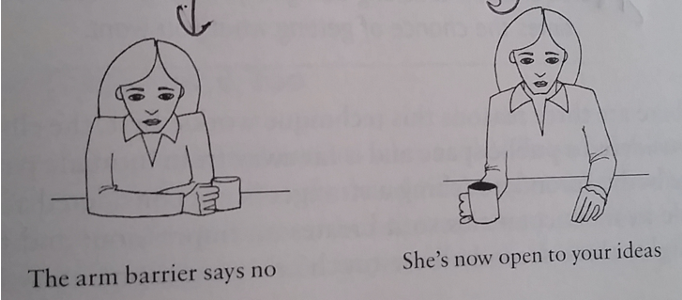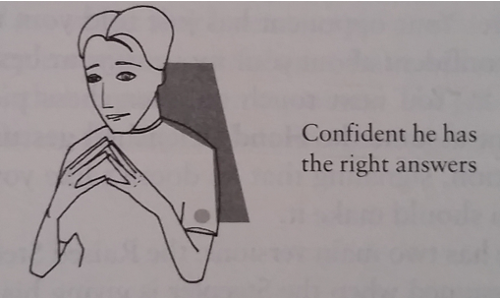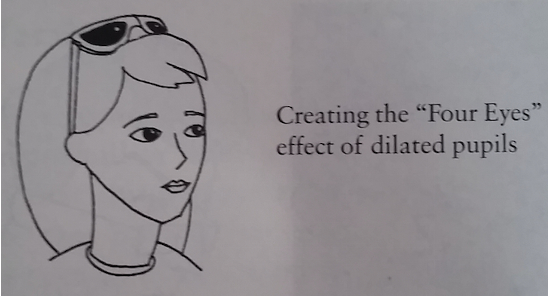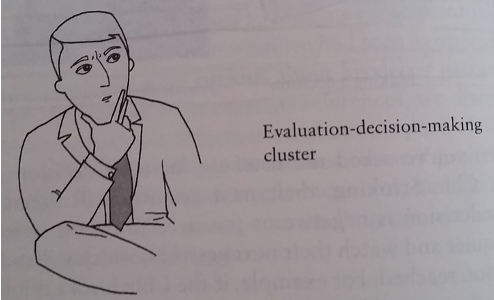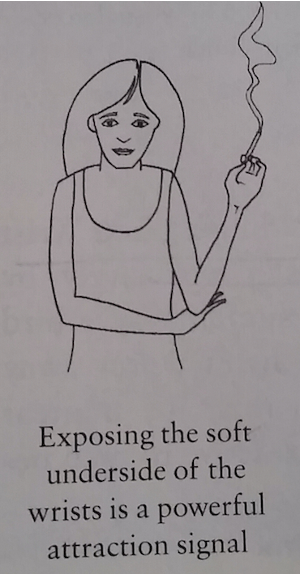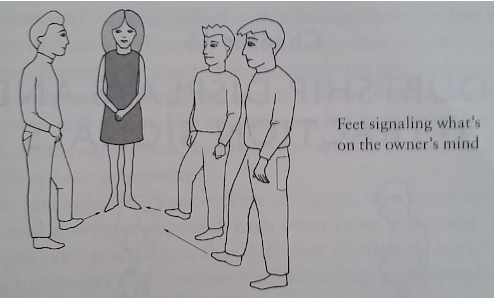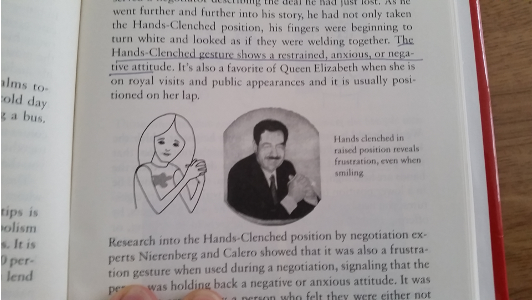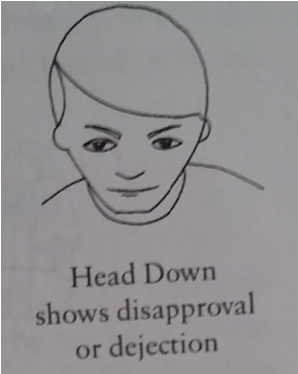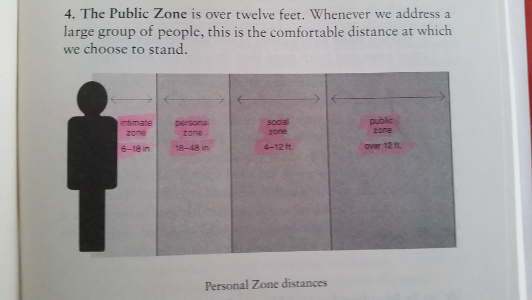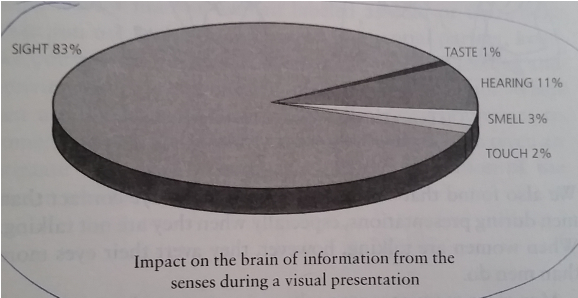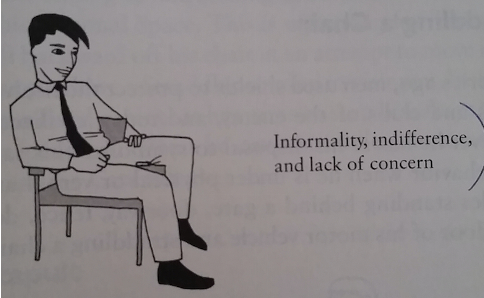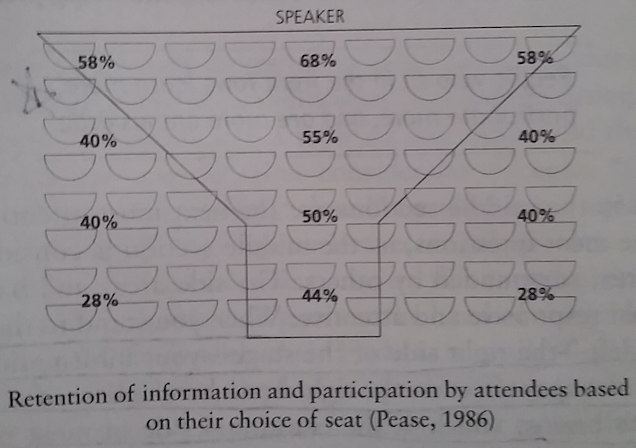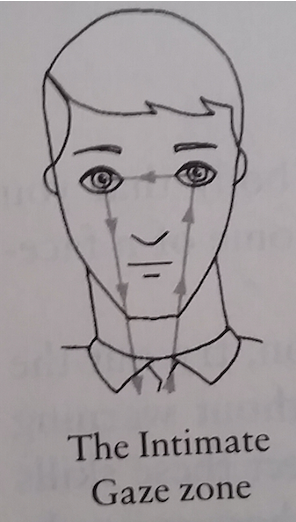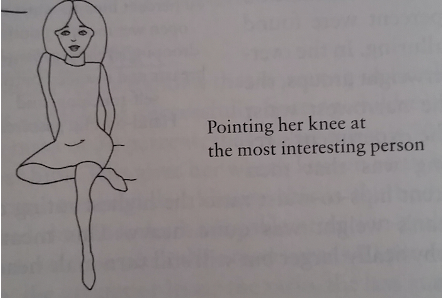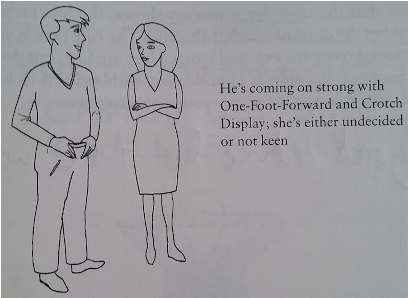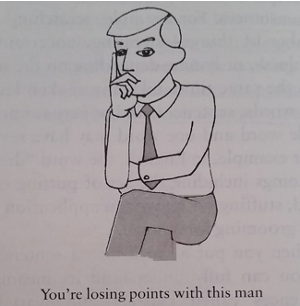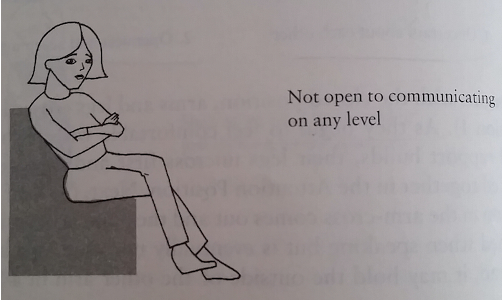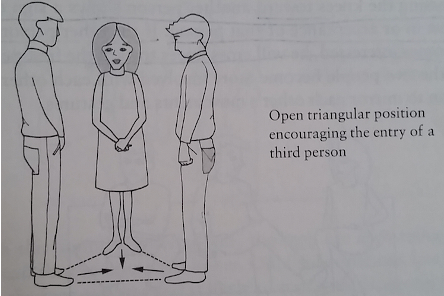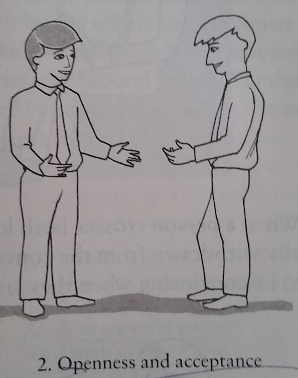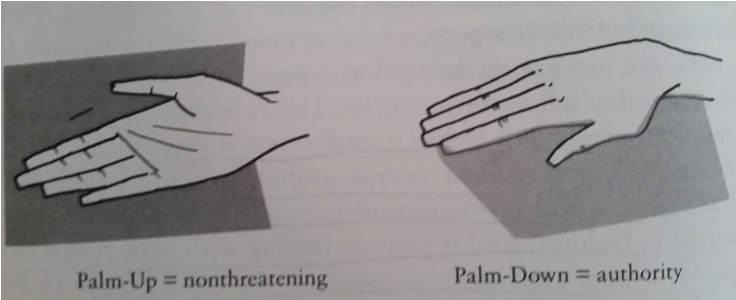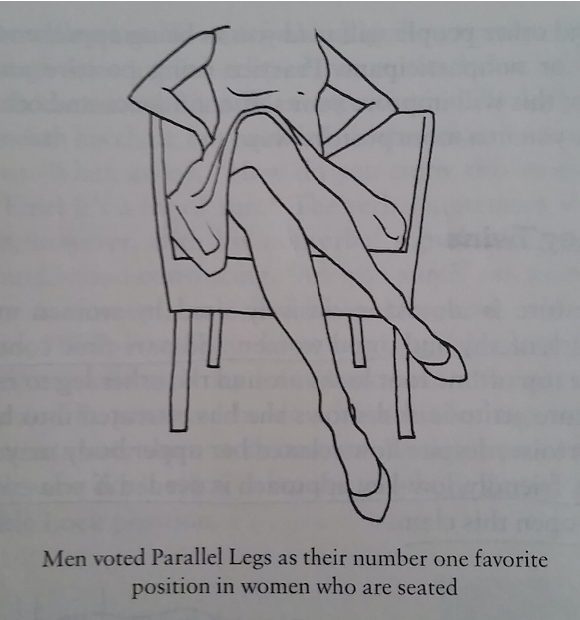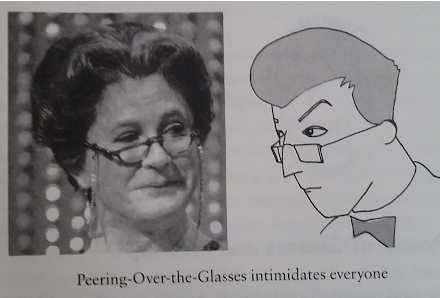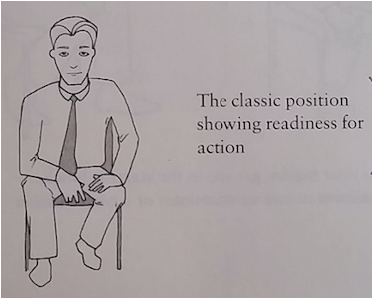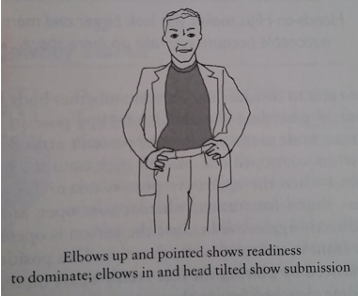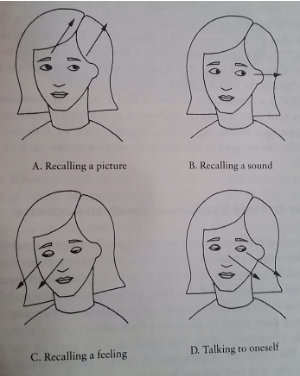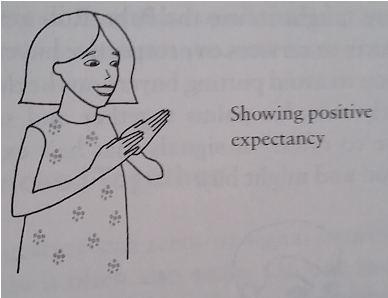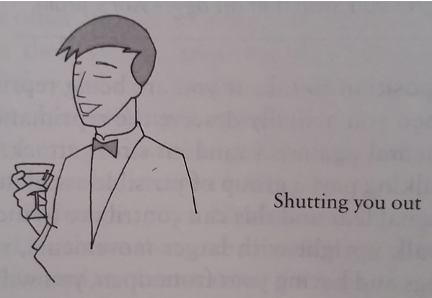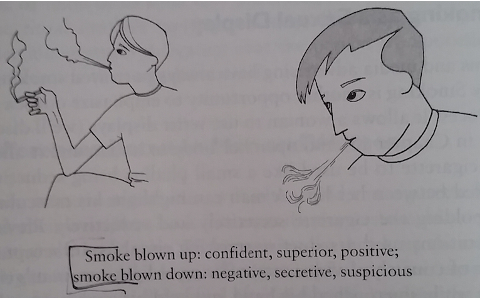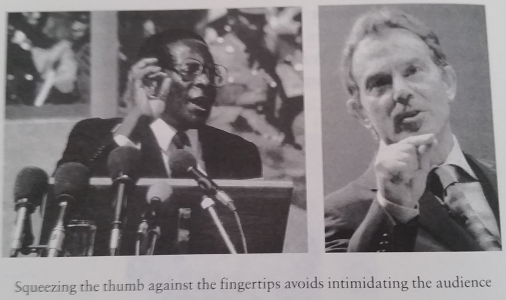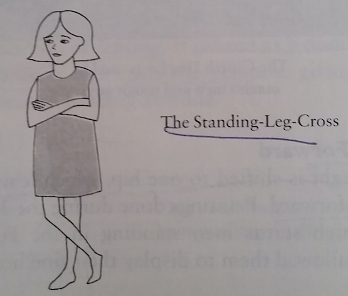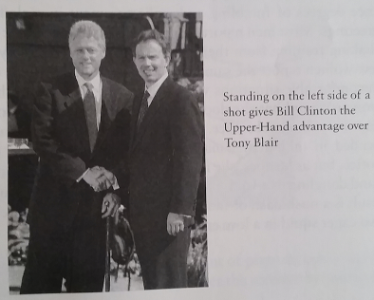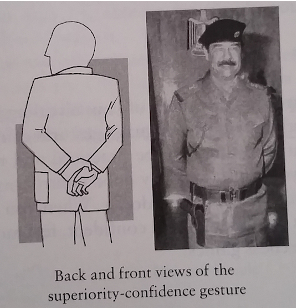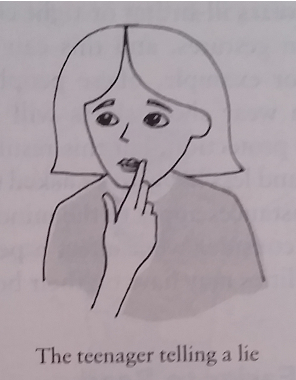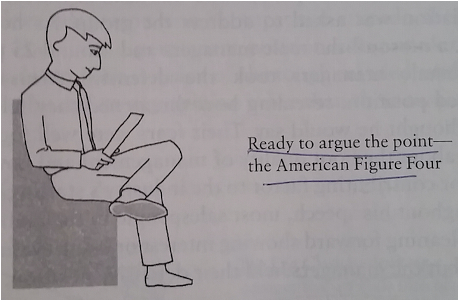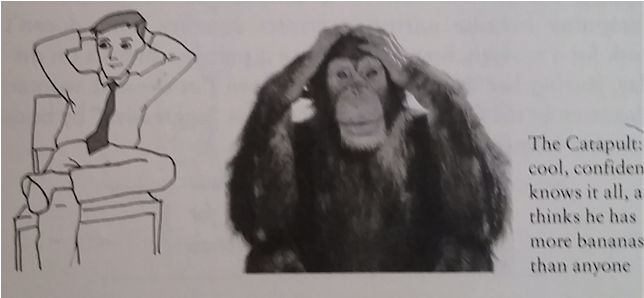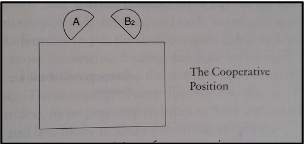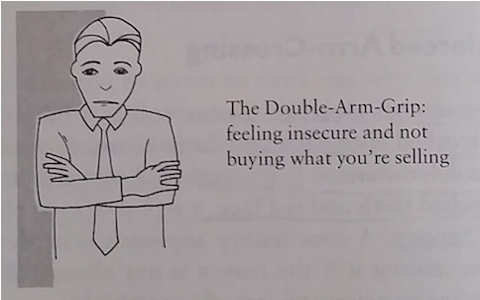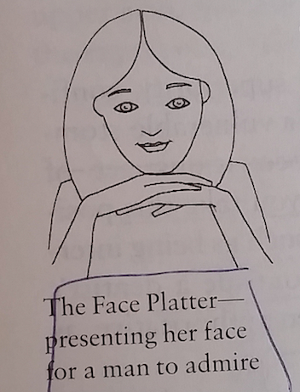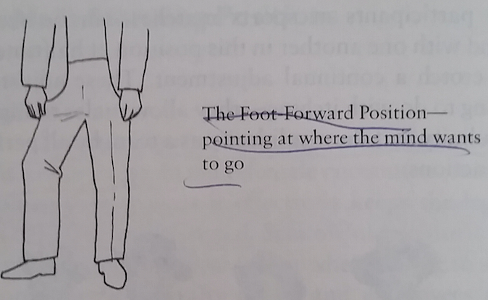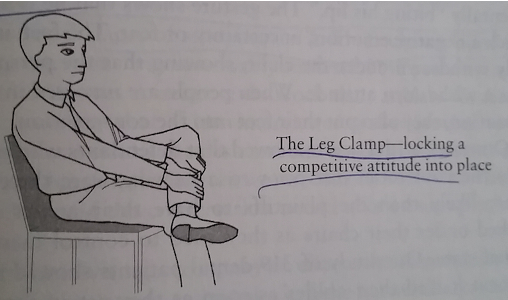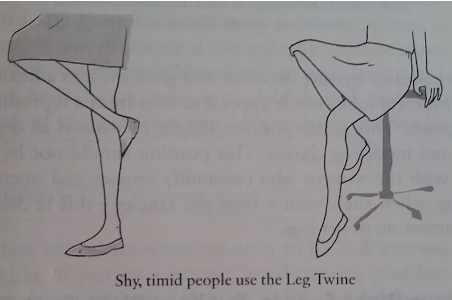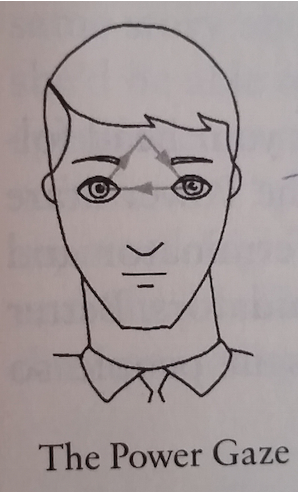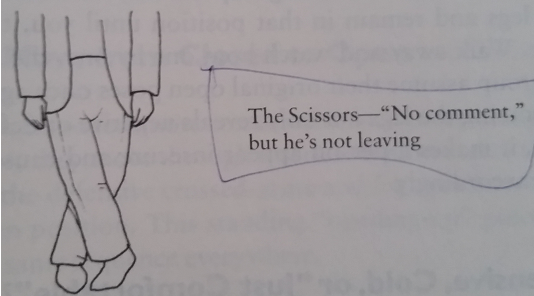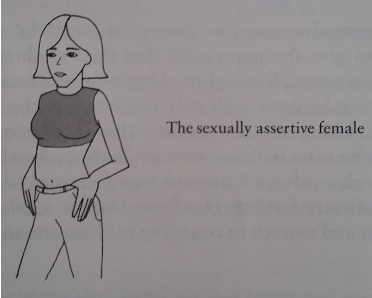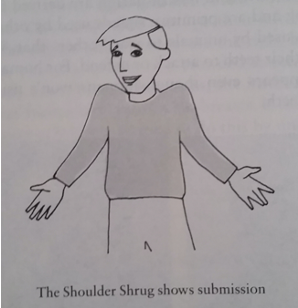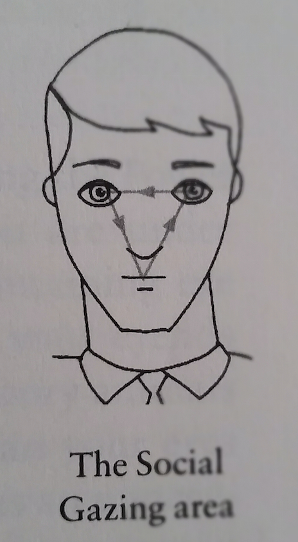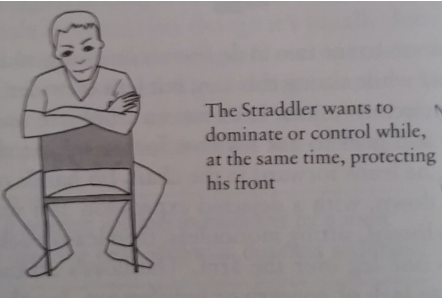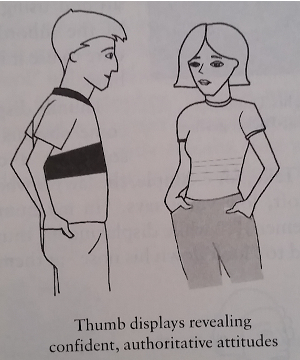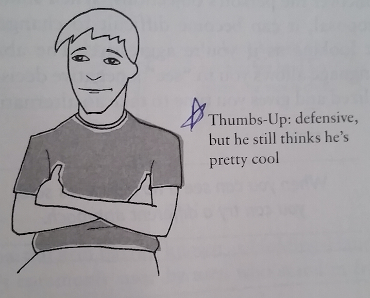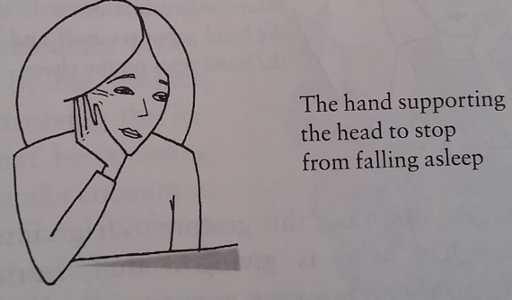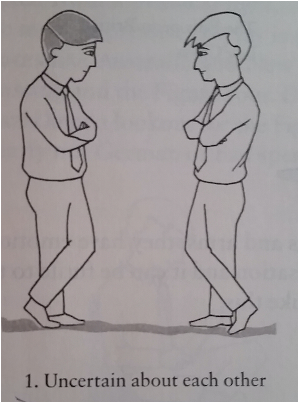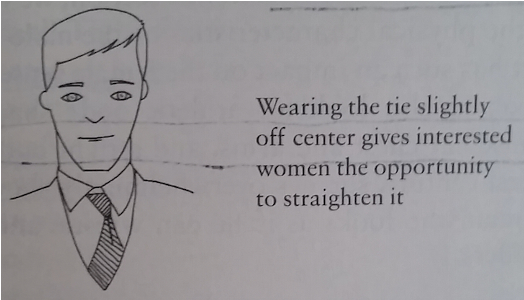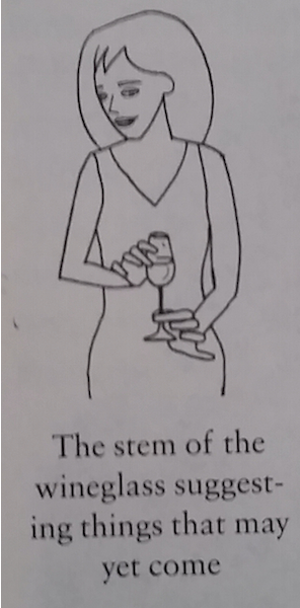Body Language by Pease
Ref: Barbara & Allan Pease (2006). The Definitive Book of Body Language. Bantam.
__________________________________________________________________________________
Summary
Body Language: An outward reflection of a person’s emotional condition.
Kinesics: Study of non-verbal communication.
Words are used primarily for conveying information, while body language is used for negotiating interpersonal attitudes and, in some cases, is used as a substitute for verbal messages.
People form 60-80% of their initial opinion about a new person in less than four minutes.
An attitude (or emotional state) causes a body language gesture to occur. Maintaining this body language gesture can force the attitude to remain.
Attractive Body Language
Face: Have an animated face, make smiling a part of your regular repertoire, occasionally flash your teeth.
Gestures: Be expressive but don’t overdo it. Keep your fingers closed when you gesture, your hands below chin level, and avoid arm or feet crossing.
Head Movement: Use triple nods when talking and head tilt when listening. Keep your chin up.
Eye Contact: Give the amount of eye contact that makes everyone feel comfortable. Unless looking at others is a cultural no-no, lookers gain more credibility than non-lookers.
Posture: Lean forward when listening, stand straight when speaking.
Territory: Stand as close as you feel comfortable. If the other person moves back, don’t step forward again.
Mirror: Subtly mirror the body language of others.
__________________________________________________________________________________
Common Gestures
Catapult: Cool, confident, knows it all. This is a seated version of the Hands-On-Hips pose except the hands are behind the head with the elbows menacingly pointed out. It’s a male gesture used to intimidate others or it implies a relaxed attitude. This is the trademark gesture of men who like you to realize just how knowledgeable they are.
If you are a woman and a man does this, continue the conversation standing up. This forces the Catapulter to change position so he can continue the conversation. When he stops the Catapult, sit down again. If he catapults again, stand up. This is a nonaggressive way of training others not to try to intimidate you.
Chair Straddling: The straddler wants to dominate or control while at the same time, protecting his front. The easiest way to disarm the straddle is to stand up or sit behind him, making him feel vulnerable to attack and forcing him to change his position.
Cowboy Stance: Thumbs tucked into the belt or into the tops of the pockets, frames the genital area and is a display used mainly by men to show a sexually aggressive attitude.
Critical Evaluation Gesture: Hand to face gesture with the index finger pointing up the cheek while another finger covers the mouth and the thumb supports the chin. Further evidence that this listener is having critical thoughts about what he hears is supported by the legs being tightly crossed and the arm crossing the body (Defensive) while the head and chin are down (negative/hostile). This body language “sentence” says something like “I don’t like what you are saying” or “I disagree” or “Im holding back negative feelings.”
Hands on Hips: Universal gesture used to communicate that a person is ready for assertive action.
Shoulder Shrug: Used to show that a person doesn’t know or doesn’t understand what you are saying. It’s a multiple gesture that has three main parts: exposed palms to show nothing is being concealed in the hands, hunched shoulders to protect the throat from attack, and raised brow, which is a universal, submissive greeting.
__________________________________________________________________________________
Head
Head Up: Neutral attitude. When the head is lifted high with the chin jutting forward, it signals superiority, fearlessness, or arrogance.
Head Tilt: Submission Signal. If you are giving a presentation or delivering a speech, make a point of looking for this gesture among your audience. When you see an audience tilting their heads and leaning forward using Hand-Chin evaluation gestures, you’re getting the point across. When you listen to others, use the Head Tilt and Head Nods and the listener will begin to feel trusting toward you because you appear non-threatening.
Head Down: When the chin is down, it signals that a negative, judgmental, or aggressive attitude exists.
Head Nod: Research shows that people will talk 3-4x more than usual when the listener nods their head using groups of three nods at regular intervals. Head nodding is also contagious. After you’ve asked a question and the listener gives an answer, nod your head during his answer. When he finishes speaking, continue to nod your head another 5 times at the rate of about one nod per second. Usually, by the time you have counted to 4, the listener will begin by speaking again and give you more information. And as long as you nod and stay silent with your hand on your chin in an evaluation position, there’s no pressure on you to speak and you wont come across like an interrogator. When you listen, put your hand on your chin and give it light strokes because, as previously stated, research shows that this encourages others to keep talking.
__________________________________________________________________________________
Eyes
When someone becomes excited, their pupils can dilate up to 4x their original size. Conversely, an angry negative mood causes the pupils to contract to what are commonly known as “beady little eyes” or “snake eyes.”
Eyebrows
Lowering the Eyebrows: Shows dominance or aggression toward others.
Raising the Eyebrows: Shows submission.
The golden rule is always eyebrow flash people you like or those who you want to like you.
Looking up Cluster: Chin Down while looking up exposes the vulnerable neck.
Sideways Glance: Used to communicate interest, uncertainty, or hostility. When it is combined with slightly raised eyebrows or a smile, it communicates interest and is frequently used as a courtship signal.
Extended Blinking: A normal, relaxed blinking rate is 6-8x/min and the eyes are only closed for ~.1s. People under pressure- i.e., when they are lying- are likely to dramatically increase their blinking rate.
Darting Eyes: When the eyes dart from side to side it can look as if the person is checking out the activity in the room, but the reality is that the brain is searching for escape routes.
Gazing
Social Gaze: A triangle between the eyes and lips.
Power Gaze: Imagine the person has a third eye in the center of the forehead and look in a triangular area between the person’s “three eyes.” It works well on the person who you want to intimidate or on the person who simply won’t shut up.
Extended Gazing can create intimate feelings.
Eye Movement
Eyes Move Upwards: A person is remembering something they saw.
Eyes Move to the Side with Head Tilt: A person is recalling something they heard.
Eyes Move Down to the Right: A person is recalling a feeling or emotion.
Eyes Move Down to the Left: A person is mentally talking to themselves.
Most primates avert their gaze to show submission. If an ape is going to display aggression or is likely to attack, it will lock eyes onto his victim. To avoid being attacked, the victim will look away and try to make itself appear smaller.
__________________________________________________________________________________
Smiling
Smiling directly influences other people’s attitudes and how they respond to you. The more you smile, the more positive reactions others will give you.
Smiles are controlled by two sets of muscles.
Zygomatic Major Muscles: Run down the side of the face and connect to the corners of the mouth. The zygomatic majors pull the mouth back to expose the teeth and enlarge the cheeks.
Orbicularis Oculi Muscles: Pull the eyes back making the eyes narrow causing “crows feet.”
Insincere Smiling
The first place to check for the sincerity of a smile is to look for wrinkle lines besides the eyes.
Insincere people smile only with their mouth.
When liars lie, the left side of the smile is usually more pronounced than the right.
Tight Lipped Smile: The lips are stretched across the face to form a straight line and the teeth are concealed. It sends the message that the smiler has a secret or a withheld opinion or attitude that they will not be sharing with you. It’s a favorite of women who don’t want to reveal that they don’t like someone and is usually clearly read by other women as a rejection signal. Most men are oblivious to it.
Twisted Smile: (Peculiar to the western world) shows sarcasm.
Sideways Looking Up Smile: A regular in women’s courtship repertoire for attracting men, as its read by men as seductive and is a powerful “come-on” signal.
If men want to be more persuasive with women, they need to smile more in all contexts.
__________________________________________________________________________________
Laughter
The ability to make others laugh is perceived as a dominant trait and women prefer dominant males.
A subordinate person will laugh to appease a superior person and the superior person will make subordinates laugh- but without laughing himself- as a way of maintaining his superiority.
Alcohol loosens inhibitions and lets people laugh more, which releases endorphins. This is why well-adjusted people laugh more when they drink while unhappy people become even more despondent or even violent.
People who have trouble with laughing at the tough things in life often turn to drugs and alcohol to achieve the same feeling that endorphin-induced laughter produces.
Humor has a positive impact on counteracting stress.
The older we become, the more serious we become about life. An adult laughs an average of 15x a day; a preschooler laughs an average of 400x.
1min of solid laughter provides up to 45min of subsequent relaxation.-Neurologist Henri Rubenstein.
As with smiling, when laughter is incorporated as a permanent part of who you are, it attracts friends, improves health, and extends life. When we laugh, every organ in the body is affected in a positive way. Our breathing quickens, which exercises the diaphragm, neck, stomach, face, and shoulders. Laughter increases the amount of oxygen in the blood, which not only helps healing and improves circulation, it also expands the blood vessels close to the skins surface. This is why people go red in the face when they laugh. It can also lower the heart rate, dilate the arteries, stimulate the appetite, and burn up calories.
__________________________________________________________________________________
Hands
Using hand gestures grabs attention, increases the impact of communication, and helps individuals retain more of the information they are hearing.
Palms
Open Palm: Associated with truth, honesty, allegiance, and submission. Watch for palm displays. When people want to be open or honest, they will often hold one or both palms out to the other person and say something like, “I didn’t do it!” or “I’m sorry if I upset you” or “I’m telling you the truth.”
Hidden Palms: Associated with deceit, concealment, lying. People will often hide their palms when asked a question they don’t want to answer or know they must lie.
Hands in Pockets: A favorite ploy of men who don’t want to participate in a conversation.
Palm Up: A submissive, non-threatening gesture. If you want someone to talk, you can use the palm-up as a handover gesture to let them know you expect them to talk and that you’re ready to listen.
Palm Down: Projects Immediate Authority. People will sense you’re giving them an order.
Palm-Closed-Finger Pointed: Used like a symbolic club with which the speaker figuratively beats his listeners into submission. Subconsciously, it evokes negative feelings in others. This gesture is one of the most annoying gestures anyone can use while speaking.
If you squeeze your fingers against your thumb to make an OK type of gesture and talk using this position, you’ll come across as authoritative, but not aggressive.
Handshakes
There are two key ingredients for creating rapport in a handshake. First, make sure that yours and the other person’s palms are in the vertical position so that no one is dominant or submissive. Second, apply the same pressure you receive.
Women who initiate a firm handshake are rated as more open-minded and make better first impressions.
It makes good business sense for women to practice firmer handshaking, particularly with men.
Dominance: Transmitted by turning your hand so that your palm faces down in the handshake. Your palm doesn’t have to face directly down, but it is the upper hand and communicates that you want to take control of the encounter.
Double Handed Handshake: Like a miniature hug; acceptable only where a hug could also be acceptable.
Two Handed Handshake: Attempts to show sincerity, trust, or depth of feeling for the receiver. The farther up the receivers arm its placed, the more intimacy the initiator is attempting to show.
Vice Handshake: A favorite of men in business and reveals a desire to dominate and assume early control of the relationship or put people in their place.
Handshake with Elbow Touch: Grabs attention, increases influence, makes you memorable, and creates a positive impression.
When you shake hands, extend your left arm, give a light touch on their elbow or hand as you shake, repeat their name to confirm you heard it correctly, and watch their reaction. Not only does it make that person feel important, it lets you remember their name through repetition.
The elbow-and-hand-touching waitresses makes 36% (males 22%) more tips from male diners than non-touching waitresses.
Rubbing the Palms Together: A way in which people communicate positive expectation. The speed of the hand rub signals whom the gesturer thinks will get the benefit.
Hands-Clenched: Shows a restrained, anxious, or negative attitude.
Steeple: Used in superior-subordinate interaction and that it indicates a confident or self-assured attitude. People who are confident, superior types often use this gesture and, by doing so, signal their confident attitude.
As a general rule, the steeple should be avoided when you want to be persuasive or win the other person’s confidence, as it can sometimes be read as smugness or arrogance.
Holding Hands Behind the Back: Superiority, confidence, and power. If you take this position when you are in a high stress situation, such as being interviewed by newspaper reporters or waiting outside a dentist’s surgery, you’ll begin to feel confident and even authoritative, as a result of cause and effect.
Hand-Gripping-Wrist: A signal of frustration and an attempt at self-control. The higher up one hand grips the opposite arm, the more frustrated or angry the person is likely to be.
Thumbs
Thumb Displays: A man will use protruding thumbs around women to whom he is attracted.
Thumb Protruding from Coat Pocket: Common to those who feel they are in a superior position to others.
Arms-Folded-with-Thumbs-Pointing-Upwards: This is a double signal, showing a defensive or negative attitude (folded arms), plus a superior attitude revealed by the thumbs.
Thumb pointing is irritating to most women, particularly when a man does it.
__________________________________________________________________________________
Arm Signals
Arms Crossed: Nervous, negative, disagreeable, or defensive; very likely firmly across the chest, showing that he feels threatened. Arm folding reduces credibility. Avoid crossing your arms under any circumstances unless your intention is to show others you don’t agree or don’t want to participate.
When a listener folds his arms, not only does he have more negative thoughts about the speaker, but he’s also paying less attention to what’s being said.
Fists-Arms-Crossed: Clenched fists and full arm-cross; shows hostility as well as defensiveness. If its combined with a tight lipped smile or clenched teeth and red face, a verbal or even physical attack could happen.
A simple but effective way of breaking the arms-folded position is to give the listener something to hold or give them something to do. Giving them a pen, book, brochure, or sample forces them to unfold their arms and lean forward.
Arms-Crossed-Thumbs Up: Defensive, but still cool.
Arm-Gripping: A person’s way of comforting himself with a form of self-hugging: show’s a negative, restrained attitude.
Holding Hands with Yourself: Commonly used by men who stand in front of a crowd to receive an award or give a speech to feel more secure.
Coffee Cup Barrier: Offering a refreshment during a negotiation is an excellent strategy for gauging how the other person is receiving your offer. Where a person places their cup immediately after they take a drink is a strong indicator of whether or not they are convinced or open to what you are saying. Someone who is feeling hesitant, unsure, or negative about what they are hearing will place their cup to the opposite side of their body to form a single arm barrier. When they are accepting of what they are hearing, they place the cup to the side of their body, showing an open or accepting attitude.
Sitting with your elbows on the armrest of a chair is a position of power and conveys a strong, upright image. Humble, defeated individuals let the arms drop inside the arms of the chair, so avoid this at all times unless your goal is to appear defeated.
__________________________________________________________________________________
Legs
Jiggling the Feet: The brains attempt to run away from what is being experienced.
Open or uncrossed leg positions show an open or dominant attitude, while crossed positions reveal closed attitudes or uncertainty.
Standing Positions
At Attention: A neutral attitude with no commitment to stay or go. A “no comment” signal.
Legs Apart Crotch Display: Both feet are firmly planted on the ground, making a clear statement that he has no intention of leaving. It is used as a dominance signal by men because it highlights the genitals.
Foot Forward: The body weight is shifted to one hip, which leaves the front food pointing forward. This is a valuable clue to a person’s immediate intentions, because we point out lead foot in the direction our mind would like to go. In a group situation, we point our lead foot at the most interesting or attractive person, but when we want to leave, we point our feet at the nearest exit.
Leg Cross: This is how most people stand when they are among people whom they don’t know well. Crossed legs show a closed, submissive, or defensive attitude as they symbolically deny any access to the genitals. “No Comment.” Studies show that people who lack confidence also take leg cross positions.
Seated Positions
American Figure Four: A seated version of a Crotch Display.
Figure 4 Leg Clamp: Locking a competitive attitude into place. Not only does this person have a competitive attitude, they lock the figure four into a permanent position using one or both hands as a clamp. This is a sign of the tough-minded, stubborn individual who rejects any opinion other than their own.
Ankle Lock: When an interviewee locks his ankles, he is mentally “biting his lip.” The gesture shows that he is holding back a negative emotion, uncertainty or fear.
Leg Twine: Trademark of shy and timid women. A warm, friendly, low-key approach is needed if you eventually hope to open this clam.
Parallel Legs: Position taught to women in deportment and modeling classes. Woman who constantly cross and uncross her legs when she fancies a man- this is done to draw attention to her legs.
__________________________________________________________________________________
Deceit Signals
Lying: Men lie with their body language. When men lie, their body language can be obvious. Women prefer to talk about a range of unrelated topics while doing various other activities or trying to look busy as they lie.
Even when your major body gestures are consciously suppressed, numerous small microgestures will still be transmitted. These include facial muscular twitching, dilation and contraction of pupils, sweating, flushed cheeks, eye-blinking rate increasing from ten to as many as 50 blinks per minute, and many other micro-signals that indicate deceit.
The best way to lie is over the phone or in an email.
Mouth Cover: The hand covers the mouth as the brain subconsciously instructs it to try to suppress the deceitful words that are being said.
Eye Rub: When people don’t want to look at something distasteful, they avoid a listener’s gaze by looking away.
Ear Grab: If a person grabs their ear or looks away to the side; they are trying to block the words they are hearing by putting the hand around or over the ear or tugging at the earlobe. The ear grab can also be a signal that the person has heard enough or may want to speak.
Neck Scratch: The index-finger- usually of the writing hand- scratches the side of the neck below the earlobe. This gesture is a signal of undoubt or uncertainty and is characteristic of the person who says “I’m not sure I agree.”
Boredom: When the listener begins to use his hand to support his head, it is a signal that boredom has set in and his supporting hand is an attempt to hold his head up to stop himself from falling asleep. The degree of the listeners boredom is related to the extent to which his arm and hand are supporting his head. It usually begins with the chin being supported by the thumb and then by the fist as interest wanes.
Impatience: Drumming fingers on the table and continual tapping of the feet on the floor are signals of impatience. If you are addressing a group of people and see these signals, a strategic move must be made to get the finger drummer or foot-tapper involved in the conversation to avoid his negative effect on the other listeners. The speed of the finger or foot tap is related to the extent of the person’s impatience- the faster the taps, the more impatient the listener is becoming.
Regardless of gender, people dramatically increase the number of unconscious foot movements when lying.
When we say that we have a “hunch” or “gut feeling” that someone has told us a lie, we usually mean that their body language and their spoken words do not agree.
__________________________________________________________________________________
Evaluation
Evaluation: Shown by a closed hand resting on the chin or cheek, often with the index finger pointing upward.
Interested Evaluation: The head supports itself and the hand rests on the cheek.
Genuine Interest: Shown when the hand lightly rests on the cheek and is not used as a head support.
Chin Stroking: A signal that the listener is going through the decision-making process.
__________________________________________________________________________________
Mirroring
We mirror each other’s body language as a way of bonding, being accepted and creating rapport, but we are usually oblivious to the fact we are doing it.
A powerful way to create a rapport with others is by intentionally matching their body language and posture.
The person with the highest status often makes the first moves and the others copy, usually in pecking order.
Never speak at a faster rate than the other person. Studies reveal that others described feeling ”pressure” when someone speaks more quickly than they do. A person’s speed of speech shows the rate at which the brain can consciously analyze information.
Mirroring is a good strategy to use if you are part of a presentation team. Decide, in advance, that when the team spokesperson makes a gesture or takes a copter speaking, the entire team will mirror. This not only gives your team the powerful parents of being cohesive, confronting the hell out of competitors who suspect something is, even though they can’t quite figure out what it is.
In any new meeting with someone, mirror the seating position, posture, body angle, gestures, expressions, and tone of voice. Before long, they will start to feel that there’s something about you they like- they’ll describe you as “Easy to be with.”
__________________________________________________________________________________
Glasses
Putting Glasses Back On: Means that someone wants to ”see“ the facts again.
Folding Glasses and Putting Them Away: Signals an intention to terminate the conversation.
Throwing Glasses on Desk: Symbolically rejecting the proposal.
__________________________________________________________________________________
Attraction
When a person wants to attract the opposite sex, they do so by emphasizing sexual differences. To discourage the opposite sex, we play down or hide these differences.
Studies into courtship show that women make the first move by sending a series of subtle eye, body, and facial signals to the targeted man, who, assuming he is perceptive enough to pick them up, responds to them. Women tend to bombard men with courting rituals in the first minutes of meeting them.
Attraction Process
Eye Contact: She looks across the room and spots a man she fancies. She waits till he notices her, then holds his gaze for about 5s and then turns away. He now keeps watching her to see if she does it again. A woman needs to deliver this gaze, on average, 3x before the average man realizes what’s happening. This gaze process can be repeated several times and is the start of the flirting process.
Smiling: She delivers one or more fleeting smiles. This is a quick half smile that is intended to give a prospective man the green light to make an approach. Unfortunately, many men are not responsive to these signals, leaving the woman feelings that he’s not interested in her.
Preening: She sits up straight to emphasize her breasts and crosses her legs or ankles to show them to best advantage or, if she’s standing, she tilts her hips and tilts her head sideways toward one shoulder, exposing her bare neck. She plays with her hair for up to 6s- suggesting she is grooming herself for her man. She may lick her lips, flick her hair, and straighten her clothing and jewelry. He’ll respond with gestures such as standing up straight, pulling his stomach in, expanding his chest, adjusting his clothing, touching his hair, and tucking his thumbs into his belt. They both point their feet or entire bodies towards each other.
Talk: He approaches and attempts to make small talk, using clichés.
Touch: She looks for an opportunity to initiate a light touch on the arm, either “accidental” or otherwise. A hand touch indicates a higher level of intimacy than a touch on the arm. Each level of touch is then repeated to check that the person is happy with this level of intimacy and to let them know that the first touch was not accidental. Lightly brushing or touching the shoulder of a man is done to give the impression that the woman cares about his health and appearance. Shaking hands is a quick way to move to the touch stage.
Overall, a man is more attracted to a woman by the signs of her availability than by her physical attractiveness, and you can learn and practice availability signals.
Studies show that we prefer to find mates who are roughly as attractive as we are.
When two people want intimacy, their body angle changes from 45° to 0°.
Crossing the knees toward another person shows a sign of interest in or acceptance of that person. If the other person also becomes interested, they will cross their knees toward the first person.
What men describe as the ‘come-on’ look that women use- a sideways glance, dilated pupils, and intimate gazing.
Romantic encounters are most successful in dimly lit places, because everyone’s pupils dilate, creating the impression that couples are interested in each other.
Studies show that women laugh at men they’re attracted to, and men are attracted to women who laugh at them.
Humorous men look more attractive to most women.
When couples walk hand in hand, the dominant partner, often the man, walks slightly in front with his hand in the above position, palm facing backward, while she has her palm facing forward. This simple little position immediately reveals to an observer who wears the loincloths in that family.
Face Platter: Presenting the face to an admirer, common in courtship.
__________________________________________________________________________________
Female Courtship Gestures
Head Toss and Hair Flick: This is usually the first display a woman will use when she’s around a man she fancies. The head is flicked back to toss the hair over the shoulders or away from the face. Even women with short hair will use this gesture. It’s a way for a woman subtly to show that she cares about how she looks to a man.
Wet Lips and Pouting, Mouth Slightly Open: A woman’s outer genital lips are proportionately the same thickness to her facial lips. When a woman becomes sexually aroused, her lips, breasts, and genitals become larger and redder as they fill with blood.
Self-Touching: Women have dramatically more nerve sensors for experiencing touch than men, making them more sensitive to touch sensations. When a woman slowly and sensually strokes her thigh, neck, or throat, it implies that, if a man plays his cards right, he may be able to touch her in these same ways. At the same time, her self-touch lets her imagine what it might feel like if the man was initiating the touch.
Limp Wrist: A submission signal used exclusively by women and gay men.
Fondling a Cylindrical Object: Fondling cigarettes, a finger, the stem of a wineglass, a dangling earring, or any phallic-shaped object is an unconscious indication of what may be in the mind. Taking a ring off and on the finger can also be a mental representation of having sex.
Exposed Wrists: An interested woman will gradually expose the smooth, soft underside skin of her wrists to the potential male partner and will increase the rate she flashes her wrists as her interest grows. The wrist area has long been considered one of the highly erotic areas of the female body because it is one of the more delicate skin areas. The palms are also usually made visible to the man while she’s speaking.
Sideways Glance over Raised Shoulder: The raised shoulder is self-mimicry of the rounded female breasts. With partially drooped eyelids, the woman holds the man’s gaze just long enough for him to notice, then she quickly looks away.
Handbag in Proximity: The handbag becomes a strong signal of intimacy when she puts it close to a man. If she finds him particularly attractive, she may slowly fondle and caress her handbag. She can ask him to pass the handbag or to even retrieve something from it.
Knee Point: One leg is tucked under the other and points to the person she finds the most interesting. This is a relaxed position, which also takes the formality out of a conversation and gives the opportunity for a fleeting exposure of the thighs.
Shoe Fondle: Dangling the shoe on the end of the foot indicates a relaxed attitude and has the phallic effect of thrusting the foot in and out of the shoe. This unsettles many men without them knowing what is happening.
Leg Twine: One leg is pressed firmly against the other to give the appearance of high muscle tone.
High Heels: High heels enhance a woman’s sexual shape by lengthening her legs, arching her back, forcing her buttocks to protrude, making her feet appear smaller, and thrusting her pelvis forward. This is why the show with the highest heel- the stiletto- with its bondage straps, is by far the most efficient sex aide on the market.
A woman who is not interested in a man will fold her arms on her chest and cross her legs away from him, giving him the “no-go” body language, while an interested woman would open herself to him.
__________________________________________________________________________________
Male Courtship Displays
Male displays involve the show of power, wealth, and status. While a woman will dress sensually, wear makeup, and use a wide range of courtship gestures, men rev their car engines, brag about how much they earn, and challenge other men.
Male Preening Behavior: Straightening his tie, smoothing his collar, brushing imaginary dust from his shoulder, touching his cufflinks or watch, and rearranging his shirt, coat, and other clothing.
Male Crotch Obsession: The most direct sexual display a man can make toward a woman is the aggressive thumbs-in-belt gesture that highlights his crotch. He may also turn his body toward her and point his foot at her, use an intimate gaze, and hold her gaze for longer than usual. When he’s seated or learning against a wall, he may also spread his legs to display his crotch.
Crotch Adjust: The most common form of public male sexual display is the crotch adjust. The implication is that his genitalia are so large and cumbersome that they need constant attention.
Wearing a Tie to One Side: If you’re a man and you want to find out which women like you, wear a neatly pressed suit and tie, but wear the tie slightly off to one side and put a little lint on one shoulder. Any women who find you attractive can’t resist brushing the lint off and straightening your tie so that you look just right.
Voice: Women express a preference for men with deeper, smoother voices because deep tones are directly linked to testosterone levels. When a man is around a woman he fancies, he’s likely to start speaking in deeper tones to highlight his masculinity, while a responsive woman is likely to start talking in higher pitched tones to contrast her femaleness.
A small, compact butt is the favorite of women everywhere. The secret is that a tight, muscular rear is necessary to make the strong forward thrusting motion needed for successful sperm transfer during sex.
__________________________________________________________________________________
Ownership, Territory, and Height Signals
Body Extension: When someone touches property, it becomes an extension of their body, showing others that it belongs to them.
To intimidate someone, learn against, sit on, or use their possessions without their permission.
Ideal Couple Height Difference Ratio: 1: 1.09
Women are, on average, 2” shorter than men.
Every inch of height above the company norm adds almost $683 to that person’s salary package, regardless of sex. On wall street, every inch of height adds $583 to each person’s bottom line.
If someone is overbearing or standing over you while you are sitting, get up and walk over to a window and gaze outside as you discuss an issue. You will look as if you are giving deep consideration to the discussion and the bigger person can’t have a height advantage when you aren’t looking at them.
Public Zone: >12’
Social Zone: 4-12’
Personal Zone: 18-48”
Intimate Zone: 6-18”
If you want people to feel comfortable around you, the golden rule is “keep your distance.”
The distance that two people keep their hips apart when they embrace reveals clues about the relationship between them. Lovers press against each other and move within each other’s close intimate zones.
Angry Mobs: As the density of the crowd increases, each individual has less personal space and starts to feel hostile, which is why, as the size of the mob increases, it becomes angrier and uglier and fights may break out. The police try to break up the crowd so that each person can regain his own personal space and become calmer.
The closer people feel emotionally to each other, the closer they will stand to each other.
__________________________________________________________________________________
Seating Arrangements
Rectangular Tables: Create a competitive or defensive relationship between people because each person has equal space, equal frontage, and separate edges. It lets everyone take a position on a given subject and allows more direct eye contact across the table.
Square Tables: Ideal for having short, to the point, conversations or for creating superior or subordinate relationships. Most cooperation comes from the person seated beside you, and the one on the right tends to be more cooperative than the one on the left.
Round Table: Creates a relax informal atmosphere; ideal for promoting discussion among people of equal status.
Researchers at the U of O determined that people can retain up to 3x more information about things they see in their right visual field than they do in their left. Teachers almost ignore the pupils on their right. The study showed that teachers looked straight ahead 44% of the time, to the left 39% of the time, and to their right only 17% of the time.
Sitting directly opposite others creates bad vibes.
Next time you have a dinner party, try this experiment: place the shyest, most introverted guest at the head of the table, farthest from the door with their back to a wall. You will be amazed to see how simply placing a person in a powerful seating position encourages them to begin to talk more often and with more authority and how others will also pay more attention to them.
__________________________________________________________________________________
Presenting
Never tell the audience you feel nervous or overawed- they’ll start looking for nervous body language and will be sure to find it.
Use confidence gestures as you speak, even if you’re feeling terrified. Use steeple gestures, open and closed palm positions, occasional protruding thumbs, and keep your arms unfolded.
Avoid pointing at the audience, arm crossing, face touching, and lectern gripping.
When you stand to the audiences left- the right side of the stage- your information will have a stronger effect on the right brain hemisphere of your audiences’ brains, which is the emotional side in most people. Standing to the audiences right- the left side of the stage- impacts the audiences left brain hemisphere. This is why an audience will laugh more and laugh longer when you use humor and stand to the left side of the stage, and they respond better to emotional pleas and stories when you deliver them from the right side of the stage.
A speaker who takes a strong attitude to his listeners and stands straight, facing them directly is perceived as aggressive. The speaker who delivers exactly the same message but points his body away from the listener is deemed confident and cool oriented but not as aggressive. To avoid being seen as aggressive, we stand with our bodies angled 45° to each other during friendly encounters to form an angle of 90°.
Impact on the brain of information from the senses during a visual presentation: 83% Sight, 11% Hearing, 3% Smell, 2% Touch, 1% Taste.
A Wharton study in the US found that the retention of verbal presentations was only 10%. The retention rate of combined verbal and visual presentations is 50%. The study also found that using visual aids cuts the average business meeting time from 25.7 minutes to 18.6 minutes- a 28% time saving.
Power Lift: To keep control of where a person is looking, use a pen to point to the presentation and, at the same time, verbalize what he sees. Next, lift the pen from the presentation and hold it between his eyes and your eyes.
__________________________________________________________________________________
Business Meetings
In the reception Area: Always stand in a reception area- never sit. Receptions will insist you “take a seat” because when you do, you’re out of sight and they no longer have to deal with you. Stand with hand-in-hand behind your back and slowly rock back and forth on your feet (confident, controlled). This body language is a constant reminder that you are still there and waiting.
Entry into an Office: Enter without hesitation. When you walk through the door of the person’s office, maintain the same speed. People who lack confidence change gears and perform small shuffles as they enter.
Approach: Even if the person is on the phone, rummaging through a drawer, or tying his shoelaces, walk in directly and confidently with a smooth motion. Put down your briefcase, folder, or whatever is in your hands, shake the person’s hand, and immediately take a seat. Let the other person see that you are accustomed to walking confidently into offices and that you don’t expect to be kept waiting.
Handshake: Keep your palm straight and return the pressure you receive. Let the other person decide when to end the handshake. Step to the left of a rectangular desk as you approach to avoid being given a palm-down handshake. Never shake directly across a desk. Use a person’s name twice in the first 15s and never talk for more than 30s at a time.
Sitting: If you are compelled to sit in a low chair directly facing the other person, turn it away 45d from the person to avoid being stuck in the reprimand position. If you can’t angle the chair, angle your body instead.
Waiting: Always take a book, laptop, or office work, which shows that you too are busy and are not prepared to be inconvenienced. When the person who has kept you waiting comes out to meet you let them speak first, lift your head slowly from your work and greet them, then pack up smoothly and confidently.
The higher up the social or management ladder a person is, the better one is likely to be able to communicate in words and phrases.
People form up to 90% of their opinion about you in the first 4 minutes; 60-80% of that impact is nonverbal.
In any meeting, when one person has decided to end the conversation or wants to leave, they will turn their body or feet towards the nearest exit.
If you want to make others feel comfortable, use the 45° open position and, when you need to exert pressure, use the direct body point. The 45° position allows the other person to think and act independently, without feeling pressure. Never approach a man directly from the front or women from behind.
Women need to avoid signals of femaleness such as soft handshakes, short skirts, and high heels if she wants equal credibility. Women who show high feminine signals in a serious business meeting lose credibility.
__________________________________________________________________________________
Misc Quotes
“A study at UC showed that the most persuasive words in spoken language are: discovery, guarantee, love, proven, results, save, easy, health, money, new, safety, and you.”
“People choose the end toilets about 90% of the time, and if they are occupied, the midway principle is used.”
“The farther away from the brain a body part is positioned, the less awareness we have of what it is doing.”
“Lying is the oil that greases our interactions with others and lets us maintain friendly social relationships.”
“Humans are the only primates that mate face to face.”
“An American survey found the three words women would most like to hear from their male partner: You’ve lost weight.”
__________________________________________________________________________________
Terminology
Adrenal Glands: Play an important part in the regulation of growth, reproduction, and the level of the body’s defenses.
Endorphins: Chemicals released from the brain when laughing. They have a similar chemical composition to morphine and heroin and have a tranquilizing effect on the body, while building the immune system.
Perception: Ability to spot the contradictions between someone’s words and their body language.
__________________________________________________________________________________
Chronology
~2000 BCE: Lipstick is first used in Egypt to mimic the reddened genitals of the sexually aroused female.-Body Language by Pease.
__________________________________________________________________________________
